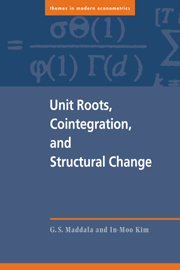Book contents
- Frontmatter
- Contents
- Figures
- Tables
- Dedication
- Preface
- Part I Introduction and basic concepts
- Part II Unit roots and cointegration
- Part III Extensions of the basic model
- Part IV Structural change
- 13 Structural change, unit roots, and cointegration
- 14 Outliers and unit roots
- 15 Regime switching models and structural time series models
- 16 Future directions
- Appendix 1 A brief guide to asymptotic theory
- Author index
- Subject index
13 - Structural change, unit roots, and cointegration
Published online by Cambridge University Press: 04 August 2010
- Frontmatter
- Contents
- Figures
- Tables
- Dedication
- Preface
- Part I Introduction and basic concepts
- Part II Unit roots and cointegration
- Part III Extensions of the basic model
- Part IV Structural change
- 13 Structural change, unit roots, and cointegration
- 14 Outliers and unit roots
- 15 Regime switching models and structural time series models
- 16 Future directions
- Appendix 1 A brief guide to asymptotic theory
- Author index
- Subject index
Summary
One major drawback of unit root tests is that, in all of them, the implicit assumption is that the deterministic trend is correctly specified. Perron (1989) argued that if there is a break in the deterministic trend, then unit root tests will lead to a misleading conclusion that there is a unit root, when in fact there is not. Perron's paper started a controversy about the effect of trend breaks on unit root tests, and a criticism that Perron assumed the break point to be known. It was argued that if the break point is treated as endogenous, then Perron's conclusions are reversed. Subsequent literature partially reversed this conclusion and also extended the problem of trend breaks to other areas such as cointegration and seasonality.
The purpose of this chapter is to present a selective survey of the literature on trend breaks in unit roots, cointegration, and seasonal integration and comment on their implications for further research. Because of space limitations technical details will be omitted. Since the literature is vast and it is easy to get lost in the details, the present chapter should help readers to get a perspective on this area. In this chapter we shall first review the literature on tests for structural change, and tests for unit roots under structural changes with a known break point and an unknown break point. We then move on to the Bayesian approach and multiple structural changes. Next we discuss the problems of the effect of structural change on cointegration tests.
Information
- Type
- Chapter
- Information
- Unit Roots, Cointegration, and Structural Change , pp. 389 - 424Publisher: Cambridge University PressPrint publication year: 1999
